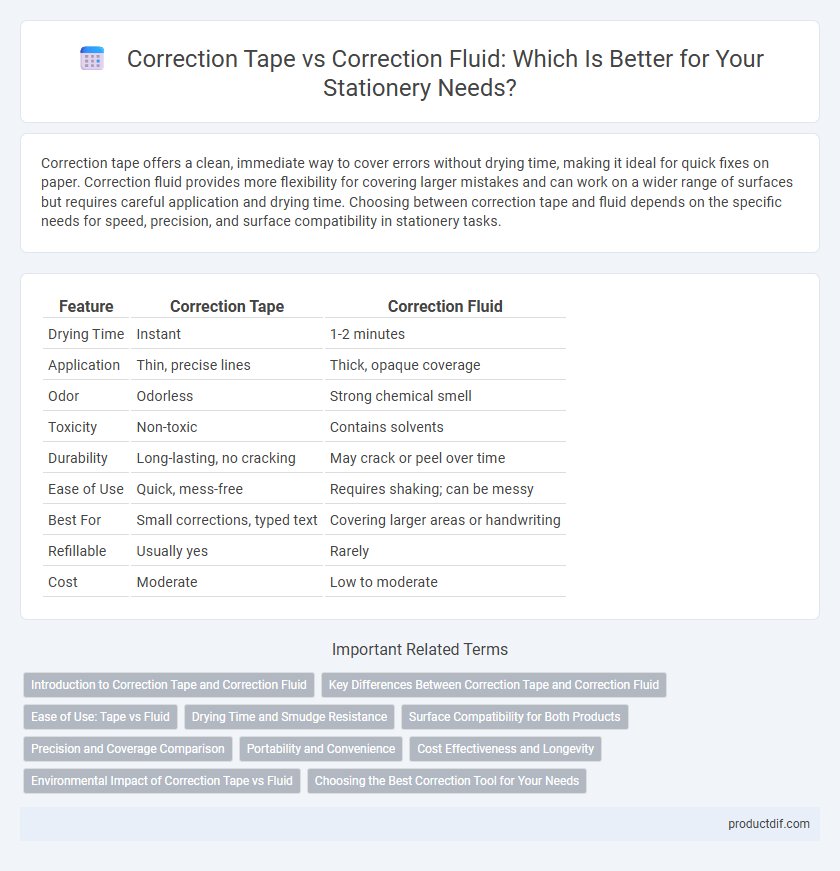Correction tape offers a clean, immediate way to cover errors without drying time, making it ideal for quick fixes on paper. Correction fluid provides more flexibility for covering larger mistakes and can work on a wider range of surfaces but requires careful application and drying time. Choosing between correction tape and fluid depends on the specific needs for speed, precision, and surface compatibility in stationery tasks.
Table of Comparison
| Feature | Correction Tape | Correction Fluid |
|---|---|---|
| Drying Time | Instant | 1-2 minutes |
| Application | Thin, precise lines | Thick, opaque coverage |
| Odor | Odorless | Strong chemical smell |
| Toxicity | Non-toxic | Contains solvents |
| Durability | Long-lasting, no cracking | May crack or peel over time |
| Ease of Use | Quick, mess-free | Requires shaking; can be messy |
| Best For | Small corrections, typed text | Covering larger areas or handwriting |
| Refillable | Usually yes | Rarely |
| Cost | Moderate | Low to moderate |
Introduction to Correction Tape and Correction Fluid
Correction tape provides a dry, mess-free method for covering errors on paper, instantly creating a smooth surface that can be written over without waiting to dry. Correction fluid, a liquid-based solution, effectively masks mistakes through quick application but requires drying time before rewriting. Both tools enhance document accuracy, with correction tape favored for convenience and correction fluid preferred for irregular surfaces or detailed corrections.
Key Differences Between Correction Tape and Correction Fluid
Correction tape offers a quick, dry method to mask errors with no drying time, making it ideal for neat, instant corrections on paper. Correction fluid requires shaking before use and drying time after application, but provides flexibility to cover larger mistakes and works on various surfaces beyond paper. While correction tape delivers a clean, precise line that can be written over immediately, correction fluid allows for more thorough coverage but demands patience during drying.
Ease of Use: Tape vs Fluid
Correction tape provides instant coverage with a dry, mess-free application that requires no drying time, making it highly convenient for quick edits. Correction fluid demands careful shaking and a drying period, often leading to smudges or uneven coverage, which can slow down the correction process. Users seeking efficiency and cleanliness typically prefer correction tape for its ease of use and immediate usability.
Drying Time and Smudge Resistance
Correction tape offers immediate drying time and excellent smudge resistance, making it ideal for quick touch-ups without waiting. Correction fluid requires several minutes to dry fully, increasing the risk of smudging if handled prematurely. For efficient and clean corrections, correction tape outperforms fluid in both drying speed and smudge-proof results.
Surface Compatibility for Both Products
Correction tape offers excellent surface compatibility on most paper types, providing a clean and immediate fix without drying time. Correction fluid works well on paper, but its wet application may cause smudging or uneven texture, especially on glossy or coated surfaces. For rough or textured paper, correction tape ensures smooth, consistent coverage, whereas correction fluid might soak in unevenly or peel off.
Precision and Coverage Comparison
Correction tape offers precise application with clean, immediate coverage, making it ideal for small errors and neat corrections. Correction fluid provides more flexible coverage, allowing for adjustment over larger areas but requires drying time that can reduce precision. Users seeking accuracy and instant use typically prefer correction tape, while correction fluid suits those needing broader, customizable coverage.
Portability and Convenience
Correction tape offers superior portability and convenience due to its dry application and immediate usability, eliminating drying time compared to correction fluid. Compact and mess-free, correction tape is ideal for on-the-go use without the risk of spills or stains. Correction fluid, while effective for covering larger errors, requires shaking and drying, making it less practical for quick, mobile corrections.
Cost Effectiveness and Longevity
Correction tape offers greater cost effectiveness due to its longer lifespan and immediate application without drying time, making it ideal for frequent use. Correction fluid, while cheaper upfront, requires drying and tends to run out faster, increasing long-term expenses. Overall, correction tape provides a more durable and economical solution for consistent stationery needs.
Environmental Impact of Correction Tape vs Fluid
Correction tape generates less hazardous waste and contains no volatile organic compounds, making it a more environmentally friendly option than correction fluid. Correction fluid releases harmful solvents and chemicals into the air, contributing to indoor air pollution and posing health risks during application. Choosing correction tape reduces chemical exposure and minimizes environmental contamination, aligning with greener office practices.
Choosing the Best Correction Tool for Your Needs
Correction tape offers instant drying and a clean, mess-free application, ideal for quick edits on important documents. Correction fluid provides greater coverage on uneven or textured paper but requires drying time and can smudge if not handled carefully. Selecting between correction tape and fluid depends on the paper type, drying speed preference, and the precision needed for your stationery tasks.
Correction tape vs Correction fluid Infographic

 productdif.com
productdif.com